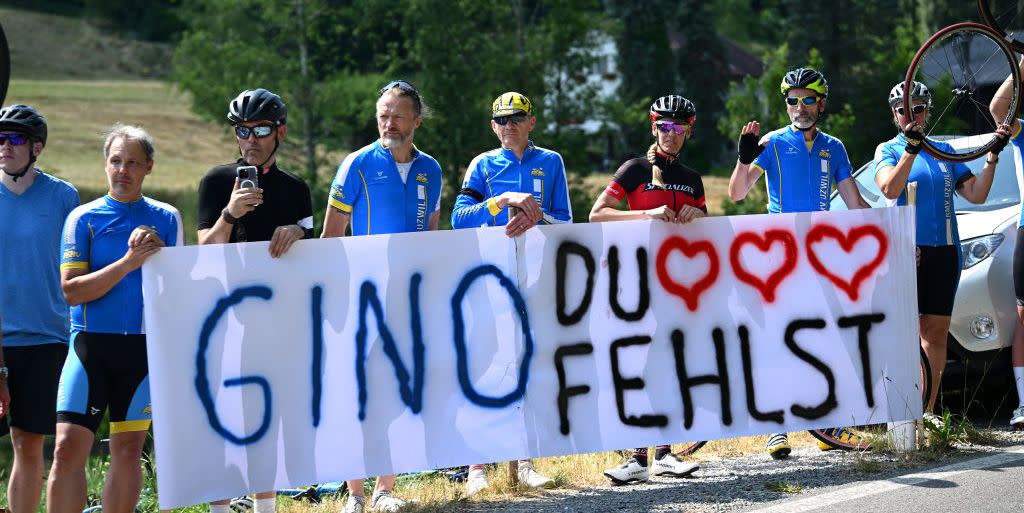Are Pro Cycling Races Too Dangerous?

Crashes are a real and unfortunate part of bike racing. And while bike racing is an inherently dangerous sport and one that has, since its inception, featured crashes, injuries, and sometimes death, relatively little has been done to further protect riders from these incidents.
Though helmet technology has come a long way in the few decades since head protection became required in bike racing, the helmet is still the only means to protect bike racers from traumatic injury.
Beyond that, bike racers have no protection from what might befall them over the course of a race. And when you consider the speeds at which these athletes race and the almost complete lack of protective measures afforded them, it’s easy to say that bicycle racing is one of the most dangerous sports in the modern age.
While racers accept this fact, it doesn’t mean nothing can be done.
Often in sports, it takes a horrible tragedy to enact change. After Fabio Jakobsen suffered a crash that nearly killed him in the closing meters of the opening stage of the 2020 Tour of Poland—one which we all suddenly and jarringly relived over the course of the Netflix series Tour de France: Unchained—the UCI set out to focus on rider safety, noting in a statement that “too many serious crashes have occurred recently.”
In concert with the UCI’s efforts, the Cyclistes Professionnels Associés (CPA), a riders’ union, was formed to demand more changes to consider the safety of riders. The group has since threatened legal action against race organizers, supported riders’ protests, and advocated for dangerous sections of road and/or unsafe conditions to be omitted from race courses.
According to a 2021 report by the New York Times, many of these measures suffered from a lack of enforcement by the UCI.
However, the UCI did focus on a handful of things in the wake of the union’s formation; namely barrier technology and obstacle protection elements throughout race courses. Of course, as recently as this March, riders were still crashing into unmarked roadside obstacles.
A few weeks after that incident, in which Sam Bennett crashed into a bike rack in the final stages of Milan-San Remo, recently appointed president of the CPA Adam Hansen referred to the current state of safety in bike racing as “a bit of a nightmare.”
While the conversation around rider safety was renewed after the women’s peloton canceled the Tour Féminin des Pyrénées on account of concerns over course safety, the talk around safety in cycling hit a fever pitch after the death of Gino Mäder in the recent Tour de Suisse. The calls for reform have been once again heightened to a level that may simply prove too much to ignore.
That Mäder’s death came just a day after several riders expressed concern over the safety of the course—most notably Remco Evenepoel publicly criticizing the race’s organizers for placing its finish line after a technical, high-speed descent rather than the mountaintop that preceded it—has seemed to add even more fuel for a renewed focus on rider safety.
What’s being done to protect riders?
Late last week, it was announced that a new independent body focused on rider safety will launch in advance of this year’s Tour de France. The group is named SAROC, an acronym for “Safe Road Cycling.”
It is a collaboration between a number of teams, including Soudal Quick-Step, Jumbo-Visma, Team DSM, and Ineos Grenadiers, with work with the UCI and a select group of race organizers in order to focus on how they can make this inherently dangerous sport as safe as it can be. The group will be funded across all participating teams, race organizers, and the UCI.
One of SAROC’s first initiatives was to compile a living database of all crashes and near-crashes in order to better analyze the causes—and therefore attempt to identify solutions—to these incidences.
They found that most crashes and near-crashes were the result of an equal combination of a pair of factors. The first is the features of a race course. That is, barriers, road obstacles, and the very makeup of a course. The second is the behavior of race participants, which not only includes riders but also race vehicles such as team cars, support vehicles, and safety and camera crews.
And while most of the finer points of SAROC’s future involvement remain a bit murky, we do know that one of their roles going forward will be to recommend stricter and more consistent punishment for in-race incidences.
The group will also be tasked with employing independent investigators beyond their own purview in order to examine not only crashes but also the safety of race courses and their safety measures. In other words, the group aims to focus as much on prevention as it does on reaction.
Whether or not SAROC’s oversight results in any real changes remains to be seen. But at least they’re trying, though, sadly too late for Gino Mäder.
According to those who knew him, Gino Mäder was a beautiful young man, one who was inquisitive, intelligent, and kind. He was also deeply invested in the future of our planet, once donating one Euro to environmental charities for each rider he beat during the 2021 Vuelta a España.
And while those personal traits might be how his friends and family remember him and his work for the environment will no doubt have an impact globally, the legacy Gino Mäder’s leaves to cycling could very well be saving someone else’s life somewhere down the road.
You Might Also Like
